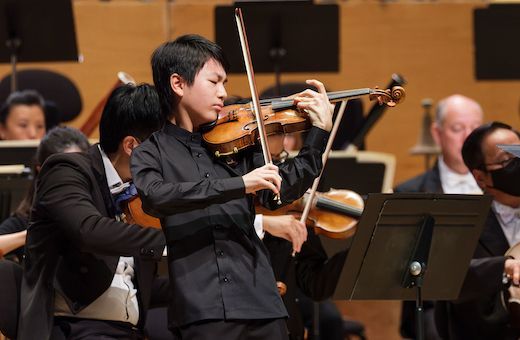Winner of the Yehudi Menuhin competition at 10, signed to Decca at 12 and now 14, violin prodigy Christian Li was showcased by the Auckland Philharmonia Orchestra on this occasion in short concertante works by Saint-Saëns and Ravel. And quite an astonishing showcase it was, with Li tackling both works with technical skill and swagger that belied his age. The concert divided neatly into two halves; the first made up of French music and the second Russian, with the former providing the more scintillating music-making of the evening.

The orchestra’s resident conductor Vincent Hardaker led confident accounts of all five scores. One would never have guessed his status as late replacement for Alan Buribayev, especially given the superlative opening performance of Fauré’s suite from Pelléas et Mélisande. The earliest of the four famous adaptations of Maeterlinck’s play into music, it had its four contrasting movements well-delineated here. Strings gleamed as they lovingly shaped the opening Prélude, with Hardaker drawing out some of the warmest and most sumptuous tone I’ve ever heard from this orchestra. He was equally adept at getting them swirling through the fast figurations of the second movement’s spinning song; the oboe melody was particularly gorgeously played here. The famous Sicilenne showed the orchestra’s ability to play with great delicacy and the final Mort de Mélisande was incredibly moving, its sombre simplicity an effective contrast to the earlier movements.
Rather than a concerto, it was refreshing to have the chance to hear two shorter works featuring Li. The opening of Saint-Saëns' Introduction and Rondo capriccioso was exquisitely shaped, warm of tone and aching in expression. The subsequent virtuoso sections were most dazzlingly rendered indeed, Li sailing through the technical challenges with no sign of strain and, indeed, with a sense of swagger that was infectious. Li also commands significant amplitude of tone, never straining to be heard as his violin line soared over the orchestral tuttis. Double-stopped sections were quite heart-stoppingly beautiful, a superb performance of a neglected showpiece. Li also applied this superb musicianship to the very different challenge in the form of Tzigane. Here, Ravel convincingly imitates the virtuosic writing typical of late-Romantic violin scores, filtered through the exoticism of ersatz Gypsy melodies, and Li was equal to every challenge. In the opening cadenza, his tone acquired an intriguing edge and surprising depth. Once again, he left no technical stone unturned, from rapid pizzicatos to ghostly harmonics to fluent trills. He is certainly a talent to watch.
Mussorgsky’s Night on the Bare Mountain opened the second half with raw power and an electrifying forward impetus. However, it felt as though the tension dropped during the more tranquil moments, though the woodwinds still played with great fluidity. It was just a pity that Rimsky-Korsakov’s arrangement was used rather than the arguably more interesting Mussorgsky original. The brusque opening of Borodin’s Symphony no. 2 in B minor was given exciting treatment, with Hardaker taking it at a cracking speed and the brass employing a weightier sound than I’m used to from this ensemble. While thrilling in these burly moments, as in the Mussorgsky, the performance was somewhat less compelling in the more lyrical sections. The second movement contains some intriguing rhythmic figures, although the contrasts between them could have been outlined more clearly and the syncopations weren’t ideally clear at the climax. Here it was the French horns that truly shone, totally secure in their rapid repeated notes. In the lovely Andante, clarinet and horns were suitably tranquil in their key melodies, and the harp maintained good clarity in its rippling opening figures. The celebratory feeling of the final movement was well-captured, bringing the evening to a satisfyingly exciting conclusion.


